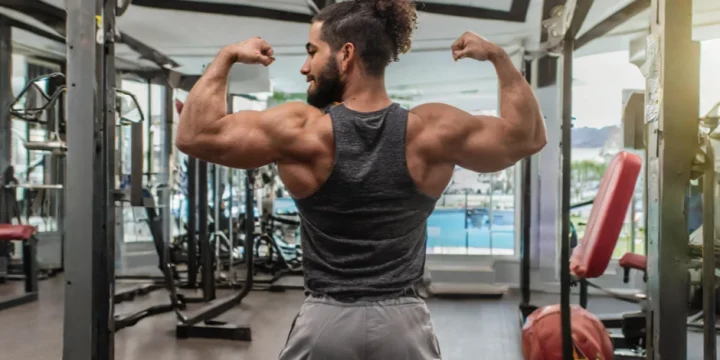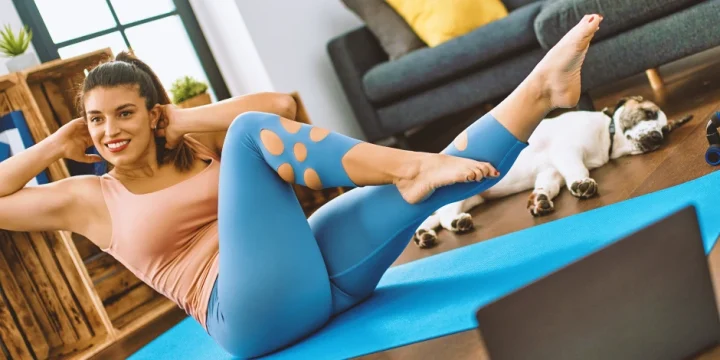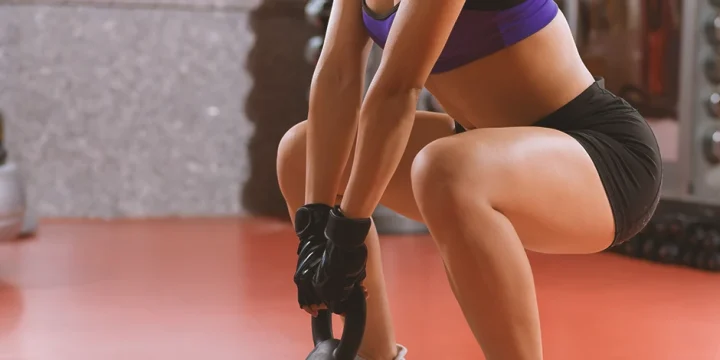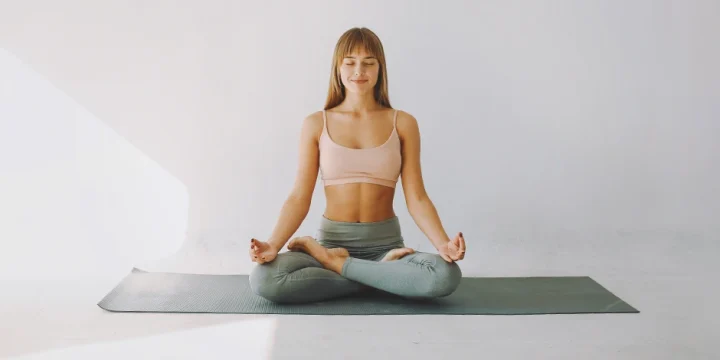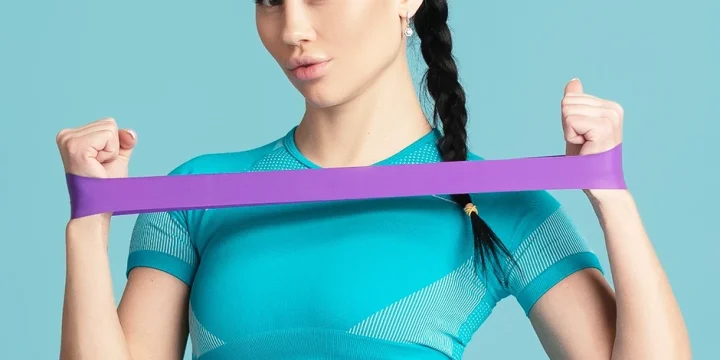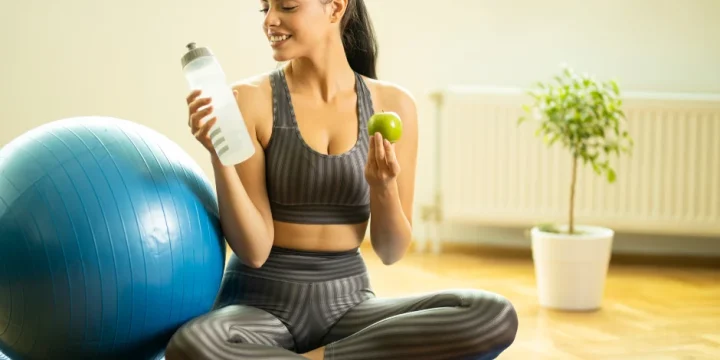Building muscle at home is challenging, especially with minimal equipment.
Yet, it's possible with the right exercises and training methods.
Based on extensive research and experience, I've identified the best home muscle-building exercises.
Also, I included instructions under the exercises section to implement principles such as progressive overload to ensure maximal muscle-building gains.
Quick Summary
- To build muscle at home, incorporate a variety of exercises like push-ups, pull-ups, squats, and lunges, focusing on both upper and lower body strength.
- Effective home muscle building requires hypertrophy programming, typically involving 3-4 sets of 6-12 reps with progressive overload.
- Hypertrophy training involving 60-87.5% load in exercises, significantly increases muscle size and strength.
- In my experience, consistency and incorporating a mix of bodyweight and resistance exercises are crucial for significant muscle gains at home.
13 Exercises to Build Muscle at Home

Each exercise was chosen based on specific criteria.
Selection criteria focused on muscle-building effectiveness, with clear instructions for each exercise.
Below you may find the 13 best exercises to build muscle at home.
"Building a lean, muscular physique complete with peaked biceps and a ripped midsection isn’t as easy as those 1970s movie training montages make it seem — it takes a lot of time, steadfast dedication, and sacrifice."
- Anthony O'Reilly, Certified Personal Trainer
1. Push-up
Push-ups follow a horizontal push movement pattern, representing a staple exercise for developing upper body strength.
Push-ups are excellent for developing chest muscles such as the pectoralis major, anterior deltoid, and triceps brachii.
How to Perform Push-Ups
- Assume a starting push-up position with the core back flat and core musculature activated.
- Your head should align with your spine, so the neck section creates a physiological (read natural) cervical lordosis.
- Your arms should be at 60 degrees abduction, 45 degrees flexion, and 30 degrees internal rotation.
- Start the exercise by bending your elbows, abducting, and extending the shoulder joint to lower yourself toward the floor.
- When your chest reaches just above the floor's surface, reverse the motion to return to the starting position.
- Repeat for 4 sets, 12 reps, and rest for 90 seconds between each set.
2. Burpee
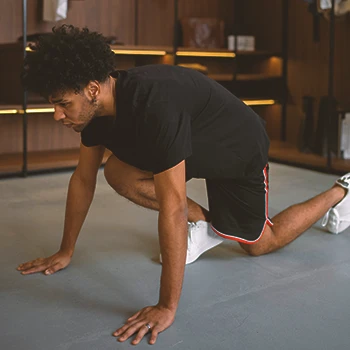
Burpees are a hybrid exercise which activates lower and upper body muscles that are a staple in beginner EMOM workouts.
However, they will mainly target your chest and shoulder muscles while also working the quads and glutes of the lower body.
How to Perform Burpees
- Assume a standing position with your feet shoulder-width apart.
- Start the exercise by bending your torso forward and down to the push-ups.
- From the push-up position, perform the full motion described in the exercise before and stop in the top position when you finish.
- Jump back to your feet or if you don’t have enough lower body power, stand first with your right leg and then follow with the left leg.
- After you reach a standing position, jump while keeping your body straight.
- Repeat for 10 reps, 3 sets, and rest for 90 seconds in between.
3. Pull-up
Pull-ups are excellent for developing your posterior deltoid, latissimus, and trapezius muscles.
They follow a vertical pull movement pattern and are a staple for popular upper body exercises for women and men to develop strength.
How to Perform Pull-Ups
- Assume a hanging position from a doorway pull-up bar or on a tree branch if lacking quality home gym equipment.
- Your elbows should be fully extended, and your shoulders should be fully abducted.
- Take a pronated grip with your hands a little wider than shoulder-width apart.
- Start the exercise by pulling your chin above the bar, flexing your elbows, and adducting the shoulders.
- Stop when your chin reaches above the bar and hold that position for one second.
- Reverse the motion by extending the elbows and abducting the shoulders to return to the starting hanging position.
- Repeat for 6 reps, 4 sets, and rest for 90 seconds between the sets.
4. Plank-up
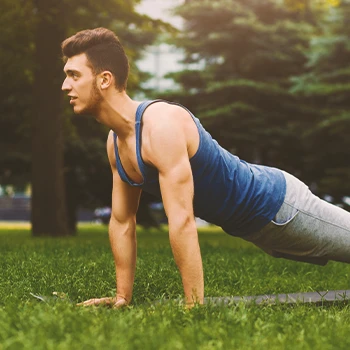
Plank-ups are a variation of the regular front plank exercise that effectively targets your core and arm muscles.
They follow the anti-extension pattern that is excellent for building a stable and functional core musculature.
How to Perform Plank-Ups
- Assume a starting front plank position with your back flat and core muscles activated.
- Your head should be in line with your spine so the neck area forms a physiological cervical curvature.
- Start the exercise by raising your right hand by extending the elbow.
- Follow that with the same motion of the left hand and reach the starting position of the push-up exercise.
- Return your right hand first and then your left to the starting plank-up position.
- Repeat for 20 reps, 4 sets, and rest for 90 seconds between the sets.
5. Triceps Dip
Triceps dips are an excellent upper body bodyweight exercises for building triceps brachii, deltoid, and pectoral muscles.
They follow a modified push pattern and are excellent for building upper body strength.
How to Perform Triceps Dips
- Pick two chairs and place them in front of each other so there is enough space for your body to fit in between.
- Place both your hands on each chair and look away from them so your hands remain on their surface while being placed slightly behind your body.
- Start the exercise by lowering yourself down between the chairs.
- This encompasses bending the elbow and extending the shoulder joint.
- When you reach the end range of motion, reverse the motion to return to the starting position.
- Repeat for 20 reps, 4 sets, and rest for 90 seconds between the sets.
6. Inchworm
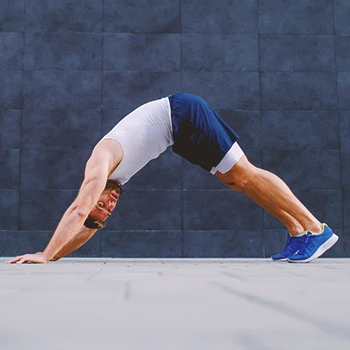
Inchworms are great for building muscular endurance in your upper body and developing your core muscles.
How to Perform Inchworms
- Assume a standing position with your feet shoulder-width apart.
- Bring your hands on the floor so you enter a quadrupled position.
- Keep your back flat during the whole duration of the movement to avoid injuries.
- When your hands reach the floor, start walking on them forward without moving your feet.
- Stop when you reach the beginning push-up position and hold for 1 second.
- Reverse the motion to return to the starting position.
- Repeat for 6 reps, 4 sets, and rest for 90 seconds between the sets.
7. Step-up
Step-up is an excellent exercise for developing strong lower body muscles.
It will effectively target your glutes, hamstrings, and quadriceps muscles.
How to Perform Step-Ups
- Assume standing in front of an elevated surface such as a chair or sofa.
- Start the exercise by placing your right foot on the chair while keeping your back straight.
- Push through your right leg to bring your body to the standing position on the chair.
- Return by reversing the motion of the exercise and repeat with the left leg.
- Repeat 8 reps with both legs for 4 sets, and rest for 90 seconds between the sets.
8. Lunge
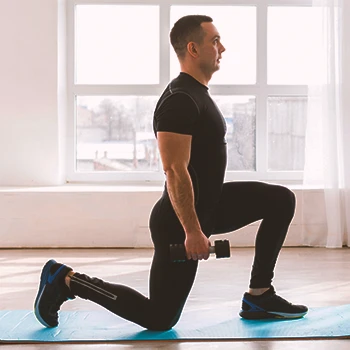
Lunges, challenging for thigh muscles, effectively develop the adductor complex, quadriceps, glutes, and hamstrings.
How to Perform Lunges
- Assume a standing position with your feet shoulder-width apart.
- Start the exercise by lunging forward with your right foot while keeping your back flat throughout the exercise.
- When your right foot touches the floor, lower your body until your right thigh is parallel to the ground.
- Push through your right foot and return to the starting position.
- Repeat the same motion with your left leg.
- Complete 6 reps with each leg for 4 sets and rest for 90 seconds between the sets.
9. Squat
Squats effectively strengthen quads, glutes, and hamstrings, essential for lower body strength.
How to Perform Squats
- Assume a standing position with your feet wider than shoulder-width apart.
- Place your hand on the hips or the back of your head.
- Start the exercise by lowering your body toward the floor.
- Bend your hips, knees, and ankles at the same time.
- When your thighs reach parallel to the ground, reverse the motion by extending the previously mentioned joint simultaneously.
- Repeat for 12 reps, 4 sets, and rest for 90 seconds between the sets.
10. Biceps Curl
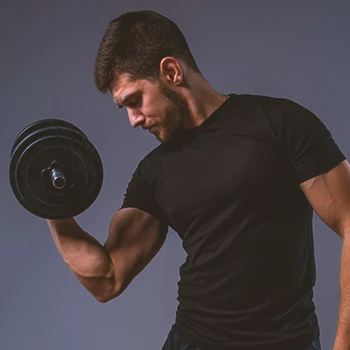
Bicep curls, done with dumbbells or kettlebells, are great for developing biceps brachii, brachialis, and brachioradialis.
How to Perform Biceps Curls
- Assume a standing position and pick two appropriate kettlebells in each hand.
- Keep your feet narrower than shoulder-width apart, and brace your core to stabilize the body.
- Start the exercise by curling kettlebells towards your shoulders.
- When you reach the top portion of the movement, hold that position for one second.
- Reverse the motion by extending the elbow joint to return to the starting position.
- Repeat for 12 reps, 4 sets, and rest for 90 seconds between the sets.
11. Triceps Extension
Triceps extensions are best performed with dumbbells, but you can use kettlebells too.
The overhead triceps extension, the best compound tricep exercise, builds all tricep heads: lateral, medial, and long.
How to Perform Triceps Extensions
- Assume a standing position and take a dumbbell in your right hand.
- Place the dumbbell overhead with your right elbows fully extended above your head.
- Keep your back flat and core tight during the whole movement.
- Start the exercise by lowering the dumbbell toward the floor. This is done by flexing your right elbow joint behind your head.
- When you reach the bottom position, extend the elbows to return the dumbbell to the starting position.
- Repeat for 8 reps, 4 sets, and rest for 90 seconds between the sets.
12. Rear Foot Elevated Split Squats
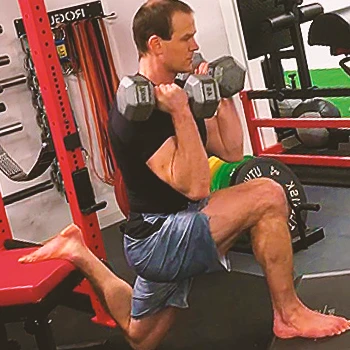
Rear foot elevated split squats are one of the best unilateral exercises for developing functional lower body strength.
They effectively target your glutes, quads, and hamstrings.
How to Perform Rear Foot Elevated Split Squats
- Assume standing in front of an elevated surface such as a chair or sofa.
- Place your left foot backward on the chair while keeping your right knee slightly flexed to maintain balance.
- Start the exercise by lowering your body towards the floor until your right leg thigh is parallel to the floor.
- Reverse the motion by extending the knee and the joint to return to the starting position.
- Repeat for 8 reps, 4 sets, and rest for 90 seconds between the sets.
How to Get the Best Results From Home Workouts?
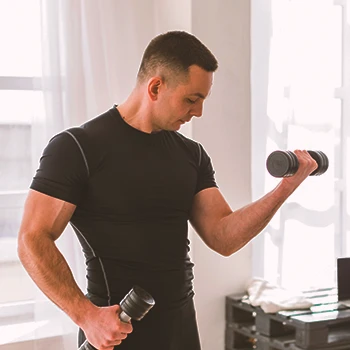
To get the best results from home workouts, you must implement different principles, such as progressive overload and hypertrophy programming principles.
Progressive overload means increasing the volume and intensity of each following home workout session for maxim benefit, efficacy of which is confirmed by the study published on the National Library of Medicine website [1].
From my own journey, I've learned that while bodyweight exercises are a great start, incorporating exercises with external resistance truly elevates your results. I remember hitting a plateau with just push-ups and squats; it was only when I started adding weights that I saw a significant improvement in muscle tone and strength. Incorporating a recommended workout routine to build muscle can further optimize your gains.
You can implement the hypertrophy programming principles if you have home gym equipment such as kettlebells or dumbbells [2].
The best number of sets to perform for hypertrophy is between 2-4, for the rep range of 6-12, but with resistance between 60 and 87.5%.
Rest at least 90 seconds between each set to maximize the muscle-building effects of lifting weights.
Also, you can’t go too hard before you make substantial progress since you may enter the state popularly known as the overtraining syndrome [3].
An overtraining syndrome is a state where your body hasn’t recovered, and you are already performing the next workout, which results in decreased performance and a bigger chance of injury [4].
"Regardless of your goals or experience level, you don’t need fancy gym equipment to get in a solid workout. Sure, it can be nice to have fun toys to play with. But all you need to gain strength, build muscle, get your heart rate up, or dip your toes into exercise is your own body."
- Alex Polish, Certified Personal Trainer
Also Read: Can You Build Muscle With a Home Gym
Fitness Equipment to Build Muscle at Home

The best fitness equipment for lower and upper body muscle growth includes:
- Dumbbells - best for developing arm muscles
- Kettlebells - best for whole-body functional training
- Medicine balls - best for explosive strength
- Resistance bands - best for developing strong and functional core muscles
- Home gyms - best for developing all muscles of your body but aren’t as affordable as the other ones
However, kettlebells are the best equipment on the list because they build functional strength, allow for the full range of motion at joints, and can be a good substitute for cardio training [5].
This is because kettlebells combine strength training with dynamic movement, increasing muscle engagement and cardiovascular benefits.
FAQs
Can You Actually Build Muscle at Home?
Yes, you can actually build muscles at home. To experience muscle growth at home and by doing bodyweight exercises, you must train frequently and use multiple sets and bigger rep ranges.
How to Build Muscle in 7 Days?
You can’t build muscles in 7 days. You can build muscles with hypertrophy or strength training in just seven days because the effects of training take longer to manifest on your body.
How Can I Build Muscle in 3 Months at Home?
You can build muscle in 3 months at home by doing resistance and exercises with your body weight. Bodyweight exercises build muscle, but exercises with external resistance yield much better hypertrophy results.
References:
- https://www.ncbi.nlm.nih.gov/pmc/articles/PMC4215195/
- https://www.ncbi.nlm.nih.gov/pmc/articles/PMC6950543/
- https://pubmed.ncbi.nlm.nih.gov/15571428/
- https://www.ncbi.nlm.nih.gov/pmc/articles/PMC3435910/
- https://pubmed.ncbi.nlm.nih.gov/30243898/
About The Author
You May Also Like
